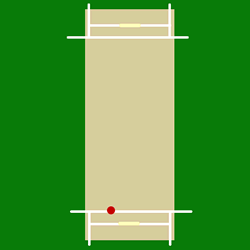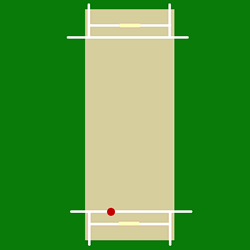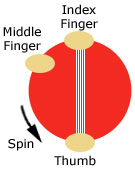Related Research Articles

Leg spin is a type of spin bowling in cricket. A leg spinner bowls right-arm with a wrist spin action. The leg spinner's normal delivery causes the ball to spin from right to left when the ball bounces on the pitch. For a right-handed batsman, that is away from the leg side, and this is where it gets the name leg break.

Off spin is a type of finger spin bowling in cricket. A bowler who uses this technique is called an off spinner. Off spinners are right-handed spin bowlers who use their fingers to spin the ball. Their normal delivery is an off break, which spins from left to right when the ball bounces on the pitch. For a right-handed batsman, this is from his off side to the leg side. The ball breaks away from the off side, hence the name 'off break'.
In the game of cricket, a googly refers to a type of delivery bowled by a right-arm leg spin bowler. It is different from the normal delivery for a leg-spin bowler in that it is actually turning the other way. The googly is NOT a variation of the typical off spin type of delivery, in that the cricket ball is presented from the bowler's hand in such a way that once the ball pitches, it deviates in the opposite direction of a leg spinning type of delivery. It has also been colloquially and affectionately referred to as the wrong'un, Bosie or Bosey, with those latter two eponyms referring to Bernard Bosanquet, the bowler who originally devised and began using the googly.

Bowling, in cricket, is the action of propelling the ball toward the wicket defended by a batter. A player skilled at bowling is called a bowler; a bowler who is also a competent batter is known as an all-rounder. Bowling the ball is distinguished from throwing the ball by a strictly specified biomechanical definition, which restricts the angle of extension of the elbow. A single act of bowling the ball towards the batsman is called a ball or a delivery. Bowlers bowl deliveries in sets of six, called an over. Once a bowler has bowled an over, a teammate will bowl an over from the other end of the pitch. The Laws of Cricket govern how a ball must be bowled. If a ball is bowled illegally, an umpire will rule it a no-ball. If a ball is bowled too wide of the striker for the batsman to be able to play at it with a proper cricket shot, the bowler's end umpire will rule it a wide.

This is a general glossary of the terminology used in the sport of cricket. Where words in a sentence are also defined elsewhere in this article, they appear in italics. Certain aspects of cricket terminology are explained in more detail in cricket statistics and the naming of fielding positions is explained at fielding (cricket).
In cricket, a yorker is a ball bowled which hits the cricket pitch around the batsman's feet. When a batsman assumes a normal stance, this generally means that the cricket ball bounces on the cricket pitch on or near the batsman's popping crease. A batsman who advances down the pitch to strike the ball may by so advancing cause the ball to pitch at or around his feet and may thus cause himself to be "yorked". Yorkers are considered to be one of the most difficult deliveries to bowl for the bowlers.
In the sport of cricket, the crease is a certain area demarcated by white lines painted or chalked on the field of play, and pursuant to the rules of cricket they help determine legal play in different ways for the fielding and batting side. They define the area within which the batsmen and bowlers operate. The term crease may refer to any of the lines themselves, particularly the popping crease, or to the region that they demark. Law 7 of the Laws of Cricket governs the size and position of the crease markings, and defines the actual line as the back edge of the width of the marked line on the soil, i.e., the edge nearest to the wicket at that end.

In cricket, batting is the act or skill of hitting the ball with a bat to score runs and prevent the loss of one's wicket. Any player who is currently batting is a batsman or batswoman, increasingly referred to as a batter, regardless of whether batting is their particular area of expertise. Batsmen have to adapt to various conditions when playing on different cricket pitches, especially in different countries - therefore, as well as having outstanding physical batting skills, top-level batsmen will have quick reflexes, excellent decision-making and be good strategists.

Fast bowling is one of two main approaches to bowling in the sport of cricket, the other being spin bowling. Practitioners of pace bowling are usually known as fast bowlers, quicks, or pacemen. They can also be referred to as a seam bowler, a swing bowler or a fast bowler who can swing it to reflect the predominant characteristic of their deliveries. Strictly speaking, a pure swing bowler does not need to have a high degree of pace, though dedicated medium-pace swing bowlers are rarely seen at Test level in modern times.

Spin bowling is a bowling technique in cricket, in which the ball is delivered slowly but with the potential to deviate sharply after bouncing. The bowler is referred to as a spinner.

An off cutter is a type of delivery in the game of cricket. It is bowled by fast bowlers.
In the sport of cricket there are two broad categories of bowlers: pace and spin. Pace bowlers rely mostly on the speed of the ball to dismiss batsmen, whereas spin bowlers rely on the rotation and turn of the ball.
Baseball and cricket are the best-known members of a family of related bat-and-ball games. Both have fields that are 400 feet (120 m) or more in diameter between their furthest endpoints, offensive players who can hit a thrown/"bowled" ball out of the field and run between safe areas to score runs (points) at the risk of being gotten out, and have a major game format lasting about 3 hours.
In the sport of cricket, a slower ball is a slower-than-usual delivery from a fast bowler. The bowler's intention is to deceive the batsman into playing too early so that he either misses the ball completely or hits it high up in the air to offer an easy catch. It is analogous to a changeup in baseball.

A delivery or ball in cricket is a single action of bowling a cricket ball toward the batsman. Once the ball has been delivered, batsmen may attempt to score runs, with the bowler and other fielders attempting to stop this by getting the batsmen out. When the ball becomes dead, the next delivery can begin.

Stumped is a method of dismissing a batsman in cricket, which involves the wicket-keeper putting down the wicket while the batsman is out of his ground.. The action of stumping can only be performed by a wicket-keeper, and can only occur from a legitimate delivery, while the batsman is not attempting a run; it is a special case of a run out.
Wrist spin is a type of bowling in the sport of cricket. It refers to the cricket technique and specific hand movements associated with imparting a particular direction of spin to the cricket ball. The other spinning technique, usually used to spin the ball in the opposite direction, is finger spin. Wrist spin is bowled by releasing the ball from the back of the hand, so that it passes over the little finger. Done by a right-handed bowler, this imparts an anticlockwise rotation to the ball, as seen from the bowler's perspective; a left-handed wrist spinner rotates the ball clockwise.
Finger spin is a type of bowling in the sport of cricket. It refers to the cricket technique and specific hand movements associated with imparting a particular direction of spin to the cricket ball. The other spinning technique, generally used to spin the ball in the opposite direction, is wrist spin. Although there are exceptions, finger spinners generally turn the ball less than wrist spinners. However, because the technique is simpler and easier to master, finger spinners tend to be more accurate.
Line and length in cricket refers to the direction and point of bouncing on the pitch of a delivery. The two concepts are frequently discussed together.
In the sport of cricket, the bowling action is the set of movements that result in the bowler releasing the ball in the direction of the batsman.
References
- ↑ Martin Crowe. It's all down to the feet. ESPNcricinfo.
- ↑ Devendra Pandey. Footwork, judging the length are the key to playing spin: Sunil Gavaskar. Indian Express.
- ↑ Flawed technique, lack of footwork tripped Kiwis. The Hindu.
- ↑ Somshuvra Laha. Wrong shot selection, footwork have cost India against spin. Hindustan Times.
- ↑ Martin Crowe. The perils of ignoring footwork. ESPNcricinfo.